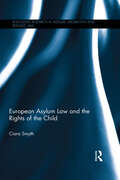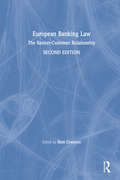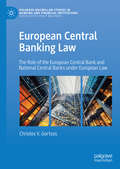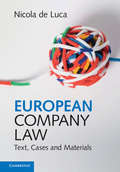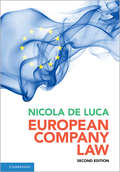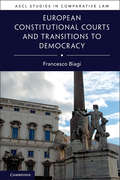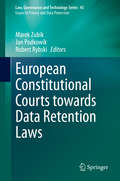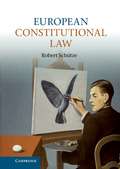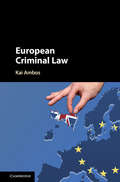- Table View
- List View
European Asylum Law and the Rights of the Child: European Asylum Law And The Rights Of The Child (Routledge Research in Asylum, Migration and Refugee Law)
by Ciara SmythThe child asylum seeker poses unique challenges for reception and refugee status determination systems, not least because the child is entitled to have his or her rights as a child respected as a matter of international and regional human rights law. In the last decade the European Union has increasingly engaged with children’s rights, with the entry into force of the Lisbon Treaty in December 2009, and a new Article 3(3) of the Treaty on European Union that commits the Union to promoting the ‘protection of the rights of the child.’ This book addresses the question of whether the Common European Asylum System (CEAS) complies with the rights of the child. It contrasts the normative standards of international child rights law with the treatment of child asylum seekers and refugees in the CEAS. Ciara Smyth identifies the attributes of the rights of the child that are most relevant to the asylum context and systematically examines whether and to what extent those attributes are reflected in the CEAS legislation. The book goes on to assess whether the CEAS instruments direct Member States to comply with the rights of the child, offering a comprehensive examination of the place of the child within European asylum law and policy. The book will be of great use and interest to scholars and students of international law, immigration and children’s rights studies.
European Banking Law: The Banker-Customer Relationship
by Ross CranstonThis text presents a practical analysis of the private law of banking transactions. Rooted in contract, the banker-customer relationship is overlaid with a range of rights and obligations having their derivation in tort, delict, notions of equity, good faith and statute. The book looks at some questions that arise within the banker-customer relationship in various European jurisdictions. What are the nature and consequences of the banker-customer relationship? Is there a duty on banks to advise customers and others about particular dealings and what liability arises if any advice given is wrong? What security can a bank take to protect itself as lender?
European Banking and Financial Law
by Matthias Haentjens Pierre de Gioia-CarabelleseIn recent decades, the volume of EU legislation on financial law has increased exponentially. Banks, insurers, pension funds, investment firms and other financial institutions all are increasingly subject to European regulatory rules, as are day to day financial transactions. Serving as a comprehensive and authoritative introduction to European banking and? financial law, the book is organized around the three economic themes that are central to the financial industry: (i) financial markets; (ii) financial institutions; and (iii) financial transactions. It covers not only regulatory law, but also commercial law that is relevant for the most important financial transactions. It also explains the most important international standard contracts such as LMA loan contracts and the GMRA repurchase agreements. Covering a broad range of aspects of financial law from a European perspective, it is essential reading for students of financial law and European regulation.
European Banking and Financial Law 2e
by Matthias Haentjens Pierre de Gioia CarabelleseOver the last few decades, banks, insurers, pension funds, investments firms and other financial institutions have become subject to sometimes dramatically new, but always substantially more, legislation. This is especially true for the EU. Moreover, Brexit has already caused profound changes to the dynamics of EU financial regulation, and its effects will likely become ever-more significant in the years to come. This book serves as a comprehensive introduction to these developments, and, more generally, to European banking and financial law. It is organised around the three economic themes that are central to the financial industry: (i) financial markets, (ii) banking and financial institutions and (iii) financial transactions. It covers not only regulatory law but also commercial law that is relevant for the most important financial transactions. This Second Edition has been completely revised. The basic structure of the First Edition has been maintained, but all chapters have been thoroughly rewritten and restructured. Attention is now also given to topics such as shadow banking and credit rating agencies. As a matter of course, all new relevant legislation and case law has been included. In addition, on the basis of real-life classroom experience, student questions and further reading suggestions have been updated and expanded.
European Banking and Financial Law Statutes
by Matthias Haentjens Pierre de Gioia CarabelleseEuropean Banking and Financial Law Statutes presents all the key legislation for European banking and financial law in one student-friendly volume. This book is: • up-to-date with the law: based on the official consolidated texts of all relevant European instruments, this book provides a fully current collection of legislation • tailored to course outlines: content has been curated to align with European banking and financial law courses • exam friendly: conforming to regulations, this is an un-annotated text that is suitable for exam use • easy to use: a clear and attractive text design, detailed table of contents and multiple indices provides ease of reference and navigation. Ideal for course and exam use, as well as for reference, this book is a perfect companion resource for student learning and exam success, which is especially tailored for use in combination with the European Banking and Financial Law textbook.
European Business Ethics Casebook
by Wim Dubbink Henk Van Luijk Luc Van LiedekerkeBusiness cases are at the heart of business ethics as a discipline. Analysis and reflection on the morality of business often is triggered by concrete cases. After four introductory chapters into recent developments within business ethics and the value of case analysis, the present volume offers extensive description of eight recent European cases, mainly stemming from The Netherlands and Belgium and all of them with a clear moral impact. Among them are the Lernout and Hauspie speech technology disaster, Heineken struggle with the promotion girls selling beer in Cambodia, cartels in the Dutch construction industry, the pharmaceutical industry and the Aids crisis, and Unilever allegedly making use of child labour in the cotton industry in India. The book will be of interest to researchers as well as teachers of undergraduate and graduate courses in Business Ethics, Business in Society, Management and Organisation Theory and Strategic Management. It will also be useful for business practitioners eager to learn about business ethics by means of cases.
European Business Ethics Cases in Context
by Wim Dubbink Henk Van Luijk Luc Van LiedekerkeBusiness ethics as a discipline leans on cases but flourishes by thorough analysis and reflection. The present volume offers both. After three introductory chapters into business ethics eight recent European cases, mainly stemming from The Netherlands and Belgium and all of them with a clear moral impact, are extensively described and analysed. Among them are the Lernout and Hauspie speech technology disaster, Heineken's struggle with the promotion girls selling beer in Cambodia, cartels in the Dutch construction industry, the pharmaceutical industry and the Aids crisis, and Unilever allegedly making use of child labour in the cotton industry in India. Each case is followed by two expert comments, from the fields of general ethics, but also of law, economics, management and organisation theory, sociology and social psychology. Cases and comments together offer an unique entrance in varieties of moral reasoning and in the personal and institutional dimensions to be taken into account when facing a corporate case saturated with moral ambiguities. This book will be of interest to researchers as well as teachers of undergraduate and graduate courses in Business Ethics, Business in Society, Management and Organisation Theory and Strategic Management. It will also be useful for business practitioners eager to find moral guidance in their specific field.
European Central Banking Law: The Role of the European Central Bank and National Central Banks under European Law (Palgrave Macmillan Studies in Banking and Financial Institutions)
by Christos V. GortsosThis book provides a comprehensive overview of European Union (EU) central banking law, a field of EU economic law which emerged in the late 1990s and has developed rapidly ever since. European central banking law pertains to the rules governing the functions, operation, tasks and powers of the European Central Bank (ECB) and the national central banks (NCBs) of EU Member States. Systematically presenting and analysing the role of the ECB as a monetary and banking supervisory authority, the book discusses its changing and developing responsibilities following the financial crisis of 2007-2009 and the ongoing fiscal crisis in the euro area. The book also highlights the ECB’s significant role in relation to the resolution of credit institutions, as well as, conversely, its relatively limited role in respect of last-resort lending to EU credit institutions exposed to liquidity risk.The related tasks and powers of the ECB are presented in light of its interaction with NCBs within the Eurosystem, the European System of Financial Supervision, the Single Supervisory System and the Single Resolution Mechanism. Providing a detailed analysis of the legal framework governing (mainly) the ECB’s monetary policy and other basic tasks within the Eurosystem and its specific tasks in relation to banking supervision and macro-prudential financial oversight, this comprehensive book will be of interest to researchers, practitioners and students in the fields of EU monetary and banking law.
European Commission Decisions on Competition
by Francesco Russo Maarten Pieter Schinkel Andrea Günster Martin CarreeEuropean Commission Decisions on Competition provides a comprehensive economic classification and analysis of all European Commission decisions adopted pursuant to Articles 101, 102 and 106 of the FEU Treaty from 1962 to 2009. It also includes a sample of landmark European merger cases. The decisions are organized according to the principal economic theory applied in the case. For each economic category, the seminal Commission decision that became a reference point for that type of anticompetitive behavior is described. For this, a fixed template format is used throughout the book. All subsequent decisions in which the same economic principle was applied are listed chronologically. It complements the most widely used textbooks in industrial organization, competition economics and competition law, to which detailed references are offered. The book contains source material for teachers and students, scholars of competition law and economics, as well as practising competition lawyers and officials.
European Company Law
by Nicola De LucaTaking a text, cases and materials approach, this is the first and only student textbook on European company law, providing an insight into the subject and shedding light on its future development. Textboxes for explanatory commentary, cases and materials - such as EU legislation, official documents and excerpts from scholarly papers - are clearly differentiated from the text, allowing the student to quickly identify sources. Each chapter also includes suggestions for further reading. Structured in seven parts, the book explores a diversity of topics, from what European company law is, the common rules for establishing, financing and accounting a company, and corporate governance, to the structure of the Societas Europaeca Statute, EU company law directives, capital markets and takeover law, and insolvency. An essential resource for the growing number of graduate courses on European company law, European business law, and comparative corporate law.
European Company Law: Text, Cases And Materials
by Nicola de LucaTaking a text, cases and materials approach, de Luca's successful textbook remains the only offering for students of European company law, and has been thoroughly updated in this new edition. Chapters have been expanded to cover the latest legislation and directives on cross-border mergers, the use of digital tools, and cross-border insolvency, while figures and graphs have been introduced to help illustrate complex processes and relationships. Clearly differentiated explanatory textboxes from the first edition have been revised, and allow students to quickly identify sources such as EU legislation, official documents and excerpts from scholarly papers. The book explores a diverse range of topics, from what European company law is, to the structure of the Societas Europaea Statute, capital markets and takeover law. It continues to be an essential resource for the growing number of graduate courses in European company law, European business law, and comparative corporate law.
European Comparative Company Law
by Mads Andenas Frank WooldridgeCompany law is undergoing fundamental change in Europe. All European countries have undertaken extensive reform of their company legislation. Domestic reform has traditionally been driven by corporate failures or scandals. Initiatives to make corporate governance more effective are a feature of recent European law reform, as are measures to simplify and ease burdens on smaller and medium-sized businesses (SMEs). An increasing EU harmonisation is taking place through the Company Law Directives, and the free movement of companies is also facilitated by the case law of the European Court of Justice on the directives and the right to free movement and establishment in the EC Treaty. New European corporate forms such as the European Economic Interest Grouping (EEIG) and the European Company (SE) have added new dimensions. At a time of rapid development of EU and national company laws, this book will aid the understanding of an emerging discipline.
European Competition Policy and Globalization
by Terrence R. Guay Chad DamroThis book examines the domestic and international dimensions of European Union (EU) competition policy, particularly mergers, anti-competitive practices and state aids. The authors argue that important changes in EU competition policy are having profound effects on the global political economy, and these changes are best understood as European Commission responses to new domestic and international pressures. Using a two-level game analytical framework that is both intra-EU and global in scope, Damro and Guay investigate a wide variety of domestic and foreign public and private actors that interact in crucial ways to determine the development and implementation of EU competition policy. They address this broad question: In what ways do changing external and internal factors affect the evolution of the EU's competition policy and the role that the Commission plays in it? Among the conclusions is that the EU – and particularly the European Commission – has become a leading global regulator.
European Competition Policy and Globalization (Palgrave Studies In European Union Politics Ser.)
by Chad Damro Terrence GuayThis book examines the domestic and international dimensions of European Union (EU) competition policy, particularly mergers, anti-competitive practices and state aids. The authors argue that important changes in EU competition policy are having profound effects on the global political economy, and these changes are best understood as European Commission responses to new domestic and international pressures. Using a two-level game analytical framework that is both intra-EU and global in scope, Damro and Guay investigate a wide variety of domestic and foreign public and private actors that interact in crucial ways to determine the development and implementation of EU competition policy. They address this broad question: In what ways do changing external and internal factors affect the evolution of the EU's competition policy and the role that the Commission plays in it? Among the conclusions is that the EU – and particularly the European Commission – has become a leading global regulator.
European Condominium Law
by Cornelius Van Der MerweThis is the first comprehensive comparative treatment of condominium (apartment ownership, commonhold, horizontal property) law in 21 European jurisdictions. This book explores the genesis of condominium law in Europe and in each of the jurisdictions represented and the use made of the condominium format to structure residential, commercial, industrial and tourist condominiums. It examines the establishment of condominiums, basic condominium concepts and the role by-laws play in establishing harmony in a condominium. Included are ten case studies, which illustrate a variety of factual scenarios and focus on providing legal solutions to practical cases. The scenarios include, amongst others, the legal consequences of a sale of apartments from building plans; restrictions on the sale and letting of apartments; the keeping of pets and the conduct of a profession (such as a medical practice) in an apartment; the sanctions against defaulters of contributions; and the requirements for undertaking maintenance and improvements.
European Constitutional Courts and Transitions to Democracy (ASCL Studies in Comparative Law)
by Francesco BiagiThis book brings together research on democratization processes and constitutional justice by examining the role of three generations of European constitutional courts in the transitions to democracy that took place in Europe in the twentieth century. Using a comparative perspective, the author examines how the constitutional courts during that period managed to ensure an initial full implementation of the constitutional provisions, thus contributing - together with other actors and factors - to the positive outcome of the democratization processes. European Constitutional Courts and Transitions to Democracy provides a better understanding of the relationship between transitions to democracy and constitutionalism from the perspective of constitutional courts.
European Constitutional Courts towards Data Retention Laws (Law, Governance and Technology Series #45)
by Marek Zubik Jan Podkowik Robert RybskiThe book analyses the impact the jurisprudence of the constitutional courts of EU Member States and the Court of Justice of the European Union has had on the perception of freedom of communications in the digital era with respect to these courts’ judgments regarding regulating storage and access to telecommunications data (known as telecommunications data retention) from 2008 to 2017. To do so, it examines the jurisprudence of the constitutional courts of Austria, Bulgaria, Cyprus, Czech Republic, Ireland, Germany, Poland, Portugal, Romania, Slovenia, and Slovakia, i.e. those courts that have already ruled on domestic provisions regulating telecommunications data retention. Further, it investigates the judgments of the Court of Justice of European Union regarding directive 2006/24/EC regulating telecommunications data retention along with relevant jurisprudence of the European Court of Human Rights. As such, the book provides a comparative study of jurisprudence and national measures to implement the Data Retention Directive. Moreover, the book discusses whether our current understanding of protection of freedom of communications guaranteed by the constitutions of EU member states and the EU Charter of Fundamental Rights, which was developed in the era of analogue communications, remains accurate in the era of digital technologies and mass surveillance (simultaneously applied by states and private corporations). In this context, the book reconstructs constitutional standards that currently apply in the EU towards data retention. This book presents a unique comparative analysis of all judgments concerning Directive 2006/24/EC, which can be used in the legislative process on the EU forum aimed at introducing new principles of data retention and by constitutional courts in the context of comparative argumentation.
European Constitutional Law
by Robert SchützeThe European Union has existed for over half a century. Having started as the 'Europe of the Six' in a specific industrial sector, the Union today has twenty-seven Member States and acts within almost all areas of social life. The Union's constitutional structures have evolved in parallel with this immense growth. Born as an international organisation, the Union has developed into a constitutional Union of States. This textbook analyses the constitutional law of the European Union after Lisbon in a clear and structured way. Examining the EU through a classic constitutional perspective, it explores all the central themes of the course: from the history and structure of the Union, the powers and procedures of its branches of government, to the rights and remedies of European citizens. A clear three-part structure and numerous illustrations will facilitate understanding. Critical and comprehensive, this is required reading for all students of European constitutional law.
European Constitutional Law
by Robert SchützeWritten with exceptional clarity and fully updated from the first edition, the second edition of European Constitutional Law constitutes a classic textbook for students and practitioners of European law. Using a clear structural framework, the text guides readers through all of the core constitutional topics of EU law. Extracts from classic case law are complemented with extensive and critical discussion of the theoretical and practical aspects of the European Union and its law, leading students to a deep understanding of the subject. Chapters are enriched with more than fifty colour figures and tables, which clarify complex topics and illustrate relationships and processes. New suggestions for further reading direct students to significant pieces of academic literature for deeper self-study, and a companion website with full 'Lisbonised' versions of the cases cited in the text completes the learning package. Integrates numerous case extracts while maintaining a continuous, single-authored narrative, and combines straightforward explanations with scholarly analysis, highlighting theoretical approaches and key academic debates. A new two-colour design emphasises case extracts and enhances figures and tables, and two new appendices provide guidance on finding, reading and understanding EU law. A new companion website includes full 'Lisbonised' versions of the cases cited in the text, organised by chapter for quick and easy access.
European Consumer Access to Justice Revisited
by Stefan WrbkaEuropean Consumer Access to Justice Revisited takes into account both procedural and substantive law questions in order to give the term 'access to justice' an enhanced meaning. Specifically, it analyses developments and recent trends in EU consumer law and aims to evaluate their potential for increasing consumer confidence in the cross-border market. Via a critical assessment of the advantages and disadvantages of the means initiated at the EU level, the author highlights possible detriments to the cross-border business-to-consumer (B2C) market. To remedy this, he introduces an alternative method of creating a legal framework that facilitates B2C transactions in the EU - 'access to justice 2. 0'.
European Consumer Protection
by Mel Kenny James Devenney"This volume analyses the theory and practice of European consumer protection in the context of consolidation initiatives seen, inter alia, in the revision of the Consumer Acquis, the Draft Common Frame of Reference and the proposal for an EU Consumer Rights Directive. The issues addressed are all the more significant given the revisions to the proposed Directive, the appointment of an 'Expert Group on a Common Frame of Reference' and the Commission's 2010 Green Paper on progress towards a European Contract Law. The contributions to this volume point to the arrival of a contested moment in EU consumer protection, questioning the arrival of the 'empowered' consumer and uncovering the fault lines between consumer protection and other goals. What emerges is a model of poly-contextual EU consumer protection law, a model that challenges the assumptions in both the 2010 Green Paper and the revised proposed Consumer Rights Directive"--
European Criminal Law
by Kai AmbosSince their creation, the European Union and the Council of Europe have worked to harmonise the justice systems of their member states. This project has been met with a series of challenges. European Criminal Law offers a compelling insight into the development and functions of European criminal law. It tracks the historical development of European criminal law, offering a detailed critical analysis of the criminal justice systems responsible for its implementation. While the rapid expansion and transnationalisation of criminal law is a necessary response to the growing numbers of free movement of persons and goods, it has serious implications for the rights of European citizens and needs to be balanced with rights protections. With its close analysis of secondary legislation and reliance on a wide variety of original sources, this book provides a thorough understanding of European Criminal Law and the institutions involved.
European Critical Infrastructure Protection
by Alessandro LazariThe recent European Council Directive 114/08 requested the EU Member States to perform an assessment aimed at the identification and designation of the so-called European Critical Infrastructures (ECI). Every analysis of the results of the "first round" of identifications and designations has only taken into account the numbers of ECIs effectively designated, consequently leaving aside all of the other elements related to this important path towards a harmonized vision of the "European Security". This work, with its unprecedented approach, focuses on the elements that have maximized or frustrated the ambitious European objectives and on the issues that might have prevented the directive reaching its full potential. Furthermore, the study offers an in-depth perspective on the lessons learned - including those that can be learned from the US pre-post 9/11 CIP policies - as well as an assessment of the state of play of the Member States after the implementation of the directive, together with predictions for future challenges.
European Data Protection: Coming of Age
by Paul De Hert Yves Poullet Serge Gutwirth Ronald LeenesOn 25 January 2012, the European Commission presented its long awaited new "Data protection package". With this proposal for a drastic revision of the data protection framework in Europe, it is fair to say that we are witnessing a rebirth of European data protection, and perhaps, its passage from an impulsive youth to a more mature state. Technology advances rapidly and mobile devices are significantly changing the landscape. Increasingly, we carry powerful, connected, devices, whose location and activities can be monitored by various stakeholders. Very powerful social network sites emerged in the first half of last decade, processing personal data of many millions of users. Updating the regulatory network was imminent and the presentation of the new package will initiate a period of intense debate in which the proposals will be thoroughly commented upon and criticized, and numerous amendments will undoubtedly be proposed. This volume brings together some 19 chapters offering conceptual analyses, highlighting issues, proposing solutions, and discussing practices regarding privacy and data protection. In the first part of the book, conceptual analyses of concepts such as privacy and anonymity are provided. The second section focuses on the contrasted positions of digital natives and ageing users in the information society. The third section provides four chapters on privacy by design, including discussions on roadmapping and concrete techniques. The fourth section is devoted to surveillance and profiling, with illustrations from the domain of smart metering, self-surveillance and the benefits and risks of profiling. The book concludes with case studies pertaining to communicating privacy in organisations, the fate of a data protection supervisor in one of the EU member states and data protection in social network sites and online media. This volume brings together some 19 chapters offering conceptual analyses, highlighting issues, proposing solutions, and discussing practices regarding privacy and data protection. In the first part of the book, conceptual analyses of concepts such as privacy and anonymity are provided. The second section focuses on the contrasted positions of digital natives and ageing users in the information society. The third section provides four chapters on privacy by design, including discussions on roadmapping and concrete techniques. The fourth section is devoted to surveillance and profiling, with illustrations from the domain of smart metering, self-surveillance and the benefits and risks of profiling. The book concludes with case studies pertaining to communicating privacy in organisations, the fate of a data protection supervisor in one of the EU member states and data protection in social network sites and online media.
European Data Protection: In Good Health?
by Paul De Hert Yves Poullet Serge Gutwirth Ronald LeenesAlthough Europe has a significant legal data protection framework, built up around EU Directive 95/46/EC and the Charter of Fundamental Rights, the question of whether data protection and its legal framework are 'in good health' is increasingly being posed. Advanced technologies raise fundamental issues regarding key concepts of data protection. Falling storage prices, increasing chips performance, the fact that technology is becoming increasingly embedded and ubiquitous, the convergence of technologies and other technological developments are broadening the scope and possibilities of applications rapidly. Society however, is also changing, affecting the privacy and data protection landscape. The 'demand' for free services, security, convenience, governance, etc, changes the mindsets of all the stakeholders involved. Privacy is being proclaimed dead or at least worthy of dying by the captains of industry; governments and policy makers are having to manoeuvre between competing and incompatible aims; and citizens and customers are considered to be indifferent. In the year in which the plans for the revision of the Data Protection Directive will be revealed, the current volume brings together a number of chapters highlighting issues, describing and discussing practices, and offering conceptual analysis of core concepts within the domain of privacy and data protection. The book's first part focuses on surveillance, profiling and prediction; the second on regulation, enforcement, and security; and the third on some of the fundamental concepts in the area of privacy and data protection. Reading the various chapters it appears that the 'patient' needs to be cured of quite some weak spots, illnesses and malformations. European data protection is at a turning point and the new challenges are not only accentuating the existing flaws and the anticipated difficulties, but also, more positively, the merits and the need for strong and accurate data protection practices and rules in Europe, and elsewhere.
